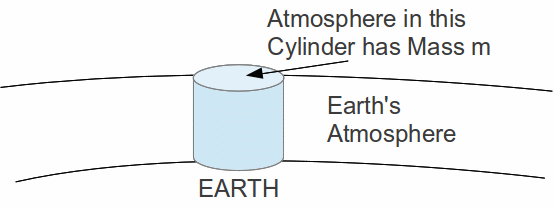The pressure in a fluid is the force per unit area that would be exerted on an empty container. The force is always exerted perpendicularly to the surface of the container and acts equally in all directions at a point. This means that if a steel ball is placed in water, the water will exert a force upwards on the underside of the ball to push the ball up, as well as on the top of the ball to push it down. The pressure due to the water is greater at the bottom than at the top, so the net effect is that the water exerts an upwards force on the ball.
The Earth's atmosphere exerts a pressure of 100,000 N/m 2 , at sea level, equivalent about 10 tonnes per square metre. This is the force due to the weight of the atmosphere above each square metre. The diagram below shows an imaginary cylinder drawn in the Earth's atmosphere.

The mass of the atmosphere in the cylinder is![]() so the weight of this air is
so the weight of this air is![]() If the base of the cylinder has area 1 m 2 , the pressure is
If the base of the cylinder has area 1 m 2 , the pressure is![]()
The density of air is not constant. Air is very compressible and the air closest to the Earth's surface is compressed by the weight of the air above it. Water on the other hand is virtually incompressible – at least for the pressures we are used to – so the density of water,![]() is constant and the mass of water is proportional to the volume. If we draw the same diagram as above in a body of water, the mass in the cylinder is
is constant and the mass of water is proportional to the volume. If we draw the same diagram as above in a body of water, the mass in the cylinder is![]() where
where![]() is the height of the cylinder, the weight of the water is
is the height of the cylinder, the weight of the water is![]() and the pressure is
and the pressure is![]()
